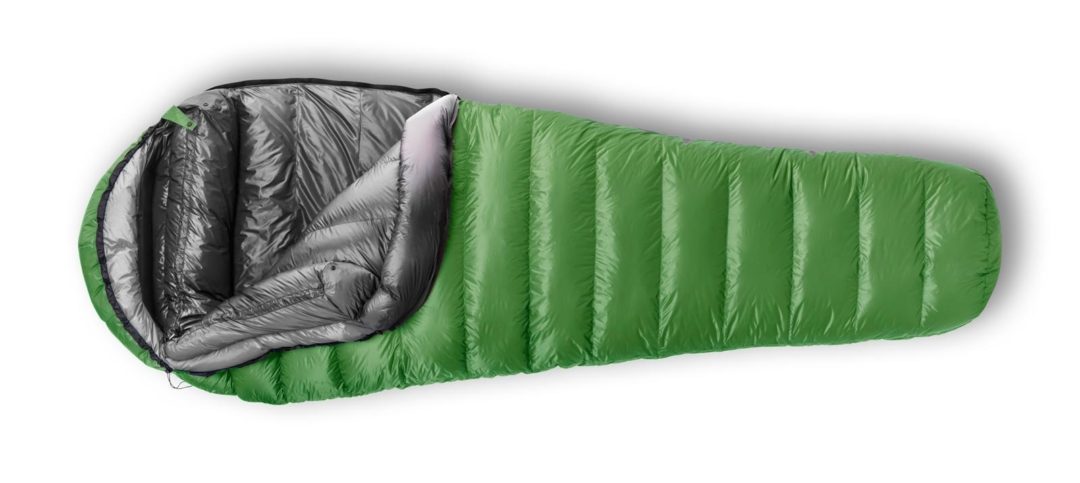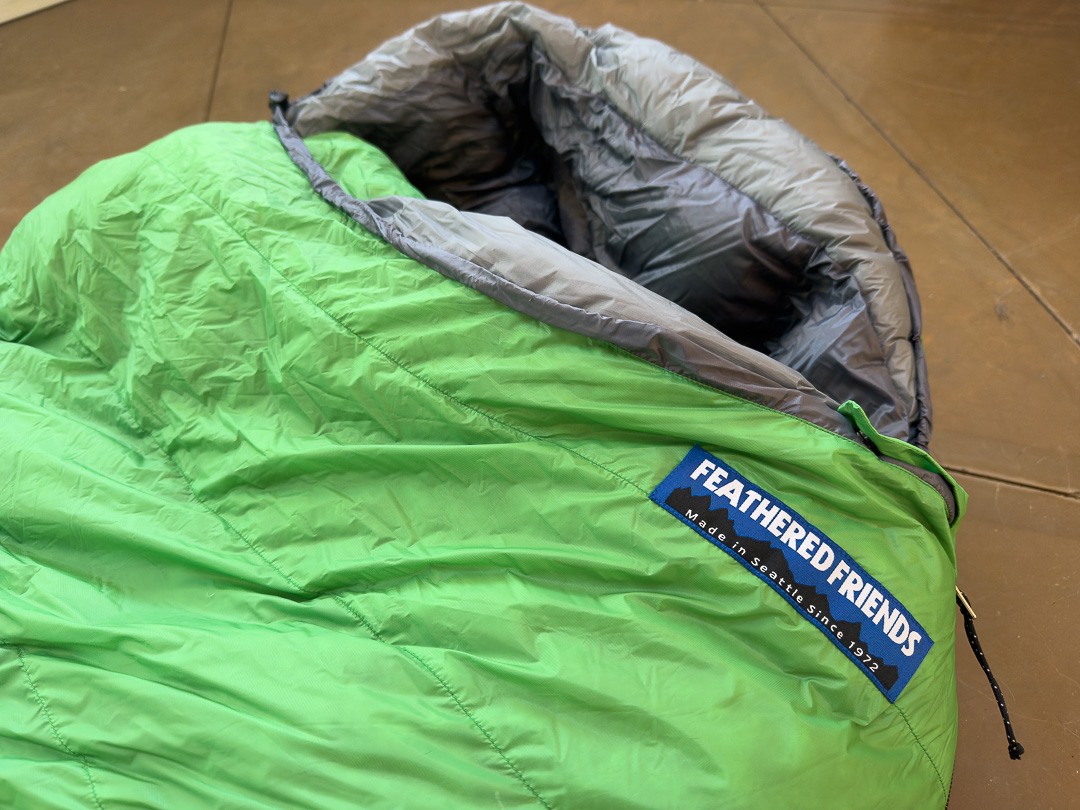Like all things “first look,” this was to be simple. A turn of the ignition. A tap on the gas pedal. A glance under the hood. But we’re talking about sleeping bags right now—not some ill-fated early 2000s Euro Van. (Been there. Sunk $ into that.) It should be known here at THR, we are into long-lived products. Sleeping bags, as unsexy as they may be, can be those beloved and durable pieces of gear.
Although a small sample size, I have a ~1993 Feathered Friends Ptarmigan Dryloft bag. It’s rated to -25 F°. I’m almost certain I custom-ordered a few ounces of overfill. Other than some outer shell punctures from a bag Vs dogs wrestling match (during which they destroyed a small portion of the side zip), the Ptarmigan remains a highly functional and well-designed bag. Although, were I to return to somewhere mighty cold, which I plan to do next spring, a mandatory zipper repair is in order. The holes have been patched.
This is to say that I’m biased towards Feathered Friends. They are a known quantity and maintain a solid reputation. I can be unbiased too—I’m aware Western Mountaineering bags are top-notch, as are offerings from several other brands. Here’s where I’m going. I’m seeking a forever home for a 10-degree down bag. My requirements are minimal weight, full side zip, hearty draft collar and hood, and a solid track record. A FF Raven 10 UL was delivered a few days ago.
Rational for a 10-Degree Bag
To be clear, I’m unsure I have one. This is an experiment I hope has a positive outcome despite my lighter wallet. Since I have a joint bank account and know my wife occasionally reads THR, here’s the rationale.
I’ve been using an older model of a TNF Inferno 0. It features a center-top zipper extending to ~½ length (to maybe the belly button). The EN rating claims a lower limit of 0°F, which, I’d say, is accurate. The bag weighs 1330g/2.9lbs (1476g with the included compression stuff sack). The bag compresses but trends towards the voluminous side of “compression.” I often use an HMG Porter 70 for multi-day winter tours, and the Inferno 0 gobbles up volume. That said, it has been a reliably warm and durable bag for this cold sleeper.
However….
- For the nights that don’t cool off or remain at, say, 15-20 degrees and warmer, the bag is overkill. With the top-oriented zipper, I find dumping heat a pain (at best) and tough to regulate. I bought the bag on sale for a very good deal—they have since upgraded to a ½ length side zip. However, I think TNF stopped making the Inferno series.
- I’m a tosser and turner. On warmer nights, I like the option of using a full-side zip bag as a blanket. That’s not an option with my Inferno 0.
- I want a slightly lighter and more compressible bag without compromising too much (or at all) on overall warmth. I hope to offset any decrease in bag warmth with insulated pants and a puffy on cold nights—items I already bring on overnight winter/spring ski objectives.
- My other sleeping bag (again, I’m a cold sleeper) is a Patagonia Fitz Roy 20-degree bag. For my internal temps, no matter how I slice it, this bag is too cold except for summer and warm fall/spring nights. The Fitz Roy does have a longer ⅔ length two-way top-zip, making it easier to dump and regulate heat or use (sort of) as a blanket. It is light and compresses into a tidy package. Before purchasing the Raven, I spent a night in the Fitz Roy 20 inside a 2P First Light using a Therm-a-Rest Neo NeoAir X-Therm pad, wearing a hoody, puffy, long-johns, and ski pants. I needed to confirm one more time that the 20-degree option was too cold. It was.
- I mostly use a winter bag in early to mid-spring for multi-day ski traverses. In a tent, a 10-degree bag (with a suitable inflatable pad) should be fine for the temps I might encounter here in the lower 48.

More on the Raven 10 UL
FF does not use the EN/ISO rating system for sleeping bags. That system provides certified bags with ratings of upper, mid, and lower limit temperatures. I’m not concerned with FF’s eschewing of the EN/ISO rating. Their bags have been around for decades, and their temp ratings are reliable. The “UL” means this iteration of Raven is constructed of slightly lighter materials than the standard Raven, and comes with higher fill power down. Let’s look at some specs.
Raven UL Stats
Fill Power: 950+ Goose Down
Shell: Pertex® Endurance UL which is 10D
Lining: Flite 15 denier ripstop nylon
Reg length dimensions (Ideal sleeper height 6′): 64″ shoulder / 58″ hip / 40″ footbox
Fill Weight (Reg): 1 lb 7.4 oz / 663 g
Confirmed bag weight: 964g/2.12 lbs., (Avg. bag weight 980 g)
Raven YF Stats
Fill Power: 900+ Goose Down
Shell: Pertex® YFuse®
Lining: 100% Recycled 20 Denier plain weave 37g/m²
Reg Length Dimensions (Ideal sleeper height 6′): 64″ shoulder / 58″ hip / 40″ footbox
Fill Weight: 1 lb 7.4 oz / 663 g
Avg bag weight: 2 lb 4.5 oz / 1036 g
Feathered Friends bags are not cheap. Accordingly, the Raven 10 UL is priced at $699.00; the Raven 10 YF is $599.99. I hope Dana, my wife, is not reading this part, but that $100 price bump to the Raven 10 UL allows me to carry 50g less and have marginally higher fill down.
Before settling on the Raven 10 UL, I tried a few bags for sizing at FF in Seattle. Initially I was sold on the Lark 10 UL—an identical bag to the Raven 10 UL with a slimmer profile. Let’s look at the Lark 10 UL dimensions.
Lark 10 UL Reg Length Dimensions: 60″ shoulder / 56″ hip / 38″ footbox
With the Raven 10 UL, I gain 4″ inches in the shoulder and 2″ in the hip and foot box, respectively. I’m a tweener. I could go with either bag. Both felt suitable when lying on my back, yet the Raven offered more comfort when placing arms by my side, whereas I felt more compelled to cross arms over my chest in the Lark 10.
Lastly, on this point, I am a side sleeper. And I am known to turnover in my sleep. The extra room in the Raven amounted to better comfort. I understand that too much room inside the bag may be less efficient at trapping body heat. I’m going with the comfort side of the equation here, and will plan on wearing the puffy in colder temps.
The Ravens and Larks—the Lark comes in a UL and YF version too—have continuous baffles. FF claims it’s easy to shift down in the bag to modify zones with more/less insulation. On the expected colder nights, I’ll experiment with shifting down to the top and, conversely, shifting down to the bag’s underside on warm nights.
We’ll report back, likely next spring, with a full-on long-term review. In the meantime, let us know if you have any questions.






Leave a Reply
You must be logged in to post a comment.